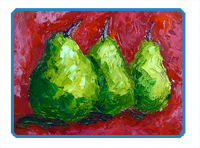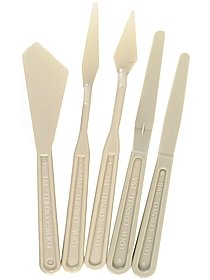
By Matt Fussell
Knife painting requires the artist to "let go" of details in a painting - to a certain extent anyway. When paint is applied to a surface with a painting knife, whether it be with oil or acrylic, it must be applied with a heavy body. Full-bodied applications require that the paint be applied without any thinning by a solvent. The result of such a thick application is a textured surface on the finished painting. Depending on the amount of paint that is applied, the surface can become almost sculptural. This effect of applying thick paint on the surface in order to produce a textural surface is known as "impasto".
The term "impasto" comes from an Italian term that refers to the process of "kneading dough" or "paste". Impasto effects occur whenever the paint is applied heavily enough to the surface that the physical texture of the surface of the painting is affected. When impasto effects are used in a painting, physical light that hits the surface of the painting can greatly affect how the painting is viewed. For this reason, the artist must consider the physical texture and how light will react on the surface.
Painting knives are often used for mixing colors on a palette, but are more commonly used for applying paint to a surface. Painting knives, like brushes, come in many different sizes and shapes depending on the intended use or desired marks. There are no rules to deciding which knives to use for specific effects. An endless number of marks and effects can be achieved with just one painting knife.
 |
Painting knives are most commonly made of either plastic or feature metal blades with wooden handles. Many artists prefer the metal knives for their durability and ease of cleaning. Although plastic knives will produce very similar, if not identical results.
As mentioned before, applying paint with a knife is best suited for heavy-bodied paints such as acrylics or oils. Oils dry very slowly and can become muddied if too much wet paint is applied. This can happen easily when paint is applied with a knife.
Acrylics, on the other hand, dry extremely fast. The fast drying time of acrylic paint helps prevent any accidental muddying that may occur. Faster drying times also allow for more layers of paint to be applied to the surface in a shorter amount of time. When layers of wet acrylic are added over areas that have dried, areas of broken color can be created - similar to scumbling effects. This added texture, although visual instead of physical, can also enhance the painting.
The following video tutorial takes a quick look at creating a knife painting using acrylic paint...
Here are some more art lessons that you may like...